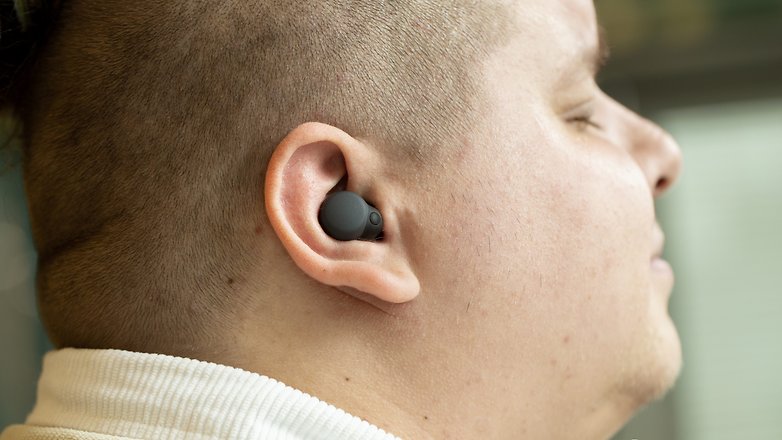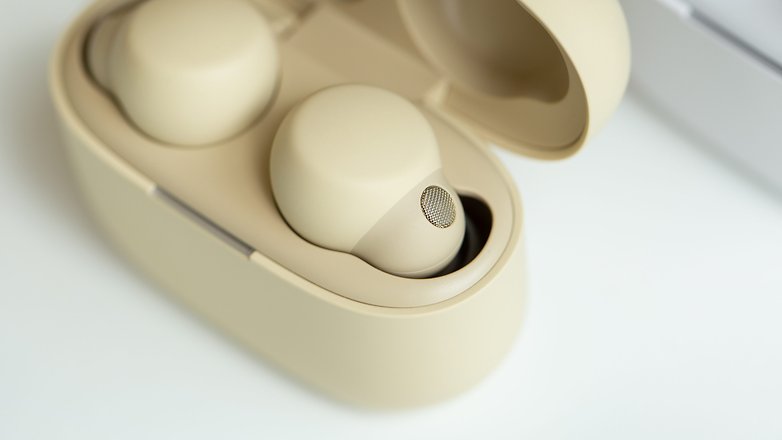Sony LinkBuds S: The world's smallest true wireless headphones with ANC


After testing the new Sony WH-1000XM5 headphones, I also took in hands the LinkBuds S, Sony's new wireless headphones with active noise reduction. These true wireless earphones with ANC sold for $199 are a more compact and affordable alternative to the Sony WF-1000XM4.
Sony LinkBuds S in a nutshell
The Sony Linkbuds S will be available from May 20, 2022, at a price of $199, and come in three colors: black, white and ecru, the same beige as the Sony WH-1000XM5 headphones.
The LinkBuds S are not intended to replace the Sony WF-1000XM4, the manufacturer's flagship headphones. No, they are a separate range formed by the first Sony LinkBuds. These were open fit earphones that were supposed to be totally open. The idea being to allow you to stay alert and aware of your sound environment without going through any transparency mode.
The LinkBuds S—in which S stands for Silence—go a bit against this logic by offering active noise reduction and a semi-in-ear format. But why do it?

Design: Very compact and discreet
The Sony LinkBuds S are headphones with a very compact form factor and a clean, minimalist design that makes them very discreet when worn in your ears. According to Sony, these are the smallest true wireless headphones in the world.
I liked:
- The matte coating and the ecru color.
- Compact form factor.
- Discreet design visually and in terms of comfort.
- Compact charging case as well.
- IPX4 certified.
I didn't like it:
- Not 100% optimal support, semi in-ear format obliges.

Sony has made huge progress on the ergonomics of its headphones recently. I still have my pair of WF-1000XM3 and they are real earbuds compared to the LinkBuds S. We've gone from the ostentatious 2000's commercial giga earpiece to a small flat 4.8 gram shell that is very subtle once placed in your ear.
Sony's idea is that you can wear them all day without even noticing them. The manufacturer speaks of a "never off" effect. For comparison, an Apple AirPods Pro earbud weighs 5.4 grams, for example.

In terms of comfort, I didn't feel any stiffness during the brief minutes I spent with the earphones for this hands-on, which isn't saying much. We are not at all on an open fit and totally open format as on the basic LinkBuds. We're not on a pure in-ear format like with the WF-1000XM4 either. The LinkBuds S offer an in-between, a semi-in-ear format with an earmold that fits in your ear canal without going too far. Kind of like AirPods Pro.

The headphones come in three colors: black, white and ecru, the same beige as the Sony WH-1000XM5 headphones that I really like. The matte coating and the beige color give the impression that the headphones are an extension of the skin. Okay, nobody really has beige skin, but just in terms of feel, it feels less like having a plastic pebble in your ear. It's a more organic feel that I found very pleasant when I readjusted one of the earpieces or tapped a touch control.
As for the rest, you can guess the grid covering the microphones intended to analyze ambient noise. As for the charging case, it is quite compact, a little less bling-bling than on the WF-1000XM4 but the feeling of premium product is there.
Audio quality: 5 mm drivers not big but strong?
The Sony LinkBuds S are not audiophile headphones, but they still offer high quality listening, thanks in part to Sony's LDAC codec.
I liked it:
- The LDAC codec and the DSEE Extreme technology.
- Multipoint Bluetooth.
- Fast pairing via Fast Pair (Android) and Swift Pair (Windows).
- Siri, Google Assistant, Alexa compatible.
Didn't like:
- aptX and aptX HD codecs not supported.
- Very small drivers.

I honestly can't comment on the audio quality of the Sony LinkBuds. I picked them up on May 5, 12 days ago as I write this. I only noticed that the 5 mm diameter of the drivers is very small. The Nothing Ear (1) have 11.6 mm drivers, for example. We also have 6 mm on the WF-1000XM4.
However, we can expect a better sound quality than on the basic LinkBuds thanks to the passive sound isolation of the LinkBuds S, made possible by their semi-insert format.
The Sony LinkBuds S obviously support the manufacturer's proprietary LDAC codec as well as the basic SBC and AAC. With LDAC, the frequency range of the LinkBuds S goes from 20 to 40,000 Hz and with SBC/AAC, it goes from 20 to 20,000 Hz.
Sony has resolutely abandoned compatibility with Qualcomm's aptx (HD) in favor of its own solution. This is something to consider if you intend to listen to your tracks in HD (CD quality, FLAC), although quite a few Android smartphones support LDAC these days, like my OnePlus 10 Pro.
In any case, the LinkBuds S also feature Sony's DSEE Extreme technology, which upscales mp3 tracks to improve audio quality.
Sony also emphasizes the quality of the microphones on its LinkBuds S. The manufacturer doesn't specify how many microphones are in each headset. I will also have to test the "Voice Focus" feature for phone calls.
ANC: Active noise reduction and ambient noise control
The Sony LinkBuds S offer active noise reduction (ANC) and other interesting features to manage your sound environment.
I liked:
- Better passive isolation of the semi-in-ear format.
- Very customizable ANC intensity
Didn't like:
- -
As explained above, the LinkBuds S differ from the basic LinkBuds mainly because they offer active noise reduction or ANC (Active Noise Cancelling).
But Sony's idea is, once again, to offer something in between. So yes, the LinkBuds S have ANC and a more efficient passive noise isolation than the normal LinkBuds, due to their semi-integrated format. But they also offer Ambient Sound Control.
Called Ambient Sound Control, this function allows you to adjust the level of ambient noise according to 20 levels of intensity. Basically, it's a 2-in-1 ANC and transparency mode that allows you to remain more or less aware of your sound environment.
The LinkBuds S can also recognize among four sound scenarios (walking outside, running outside, office, home) to automatically change the intensity of the ambient sound control, either by pushing the ANC or, conversely, by pushing the external noises.
Personally, I think Sony has made a big deal about its famous ambient sound control. I must admit I don't understand what's so special about it. It's just ANC and a transparency mode. These features are already well known.
Battery life: 6 hours of listening time with the ANC
The Sony LinkBuds S offer a total of 20 hours of battery life with the charging case. Each earbud can last 6 hours with ANC enabled and 9 hours without.
I liked:
- Solid 6-hour battery life on paper.
- Fast charging.
Didn't like:
- No wireless charging.

According to Sony, the charging case is capable of delivering up to 14 hours of battery life, or at least two recharges, before needing to be plugged into the mains itself. These figures are quite correct and consistent for this price range.
Still according to the manufacturer, 5 minutes of recharges via the USB-C cable are enough to recover 1 hour of autonomy. It takes about 2 hours to recharge the headphones from 0 to 100% with the box, and 3 hours for a full recharge of the box itself. The latter does not accept wireless charging.
Technical data
| Technical specifications | |
|---|---|
| Product | |
| Illustration |  |
| Design | Semi in-ear weight: 4.8 g (per earpiece) / 35 g (housing) | port detection | touch controls |
| Audio | 5 mm drivers | DSEE Extreme for upscaling songs |
| Frequency response |
|
| ANC |
|
| Bluetooth | 5.2 | LDAC, SBC, AAC codecs | Multipoint | Fast Pair and Swift Pair |
| Battery life |
|
| Price | $199 |
Conclusion: My first impressions
My first impressions of the Sony LinkBuds S are positive. Despite my limited use, they are good true wireless headphones with ANC in terms of quality/price ratio. I really like the "never-off" approach which emphasizes a discreet design and an optimal comfort to allow the LinkBuds S to be forgotten once worn.
I just don't understand why Sony is putting them alongside the WF-1000XM4. These ANC headphones are already among the best references on the market. Why offer yet another pair of headphones with active noise reduction?

Yes, at $199, they are more affordable than the XM4, which were sold for $278 when they were released. But why call them LinkBuds? The first LinkBuds had a unique concept, that of being totally open earphones, like on-ear headphones. It was a new product and therefore should have its own line within the Sony audio catalog.
But the LinkBuds S look like fairly standard wireless headphones. In short, it's an odd choice by Sony. But maybe who cares after all, and the clarity of a product catalog is only of interest to technobabble people like me. In any case, I hope to be able to offer you a complete test of the LinkBuds S soon to give you a more definitive opinion.




















